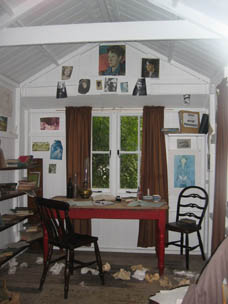Donations are being sought to ensure the survival of the cedar-shingled writing shed built and worked in by Arthur Miller from the late 1950s onwards. Originally sited on his Roxbury home in Connecticut, the 22ft x 14ft garden office studio is where he wrote the screenplay for The Crucible and stage plays including After the Fall. It was moved some years ago and sadly is currently in a parking lot awaiting a long term future, entirely inaccessible to the public.
Miller's daughter Rebecca is hoping to raise funds to enable it to be donated to the town of Roxbury and a gofundme project page has now been set up in the hopes of reaching the $1m mark - the money will go to restoring and relocate it (to the Minor Memorial Library in town, roughly $200,000) with all its original furnishings such as his desk, typewriter and chairs, as well as keep it in good shape in the future (roughly $800,000) since it's beginning to show its age and provide a location where workshops and other literary events can be held.
-------------------------------------------------------------------------








